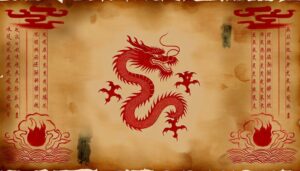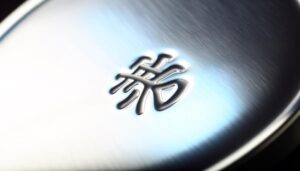7 Key Differences Between Chinese Currency Symbols Vs Japanese Yen
The Chinese yuan and Japanese yen are both represented by the symbol (¥), reflecting their shared historical roots. They were introduced in the late 19th century to strengthen economic modernization—yen in 1871 and yuan in 1889.
Despite visual similarities, their economic roles diverge significantly. The Chinese yuan (CNY) supports a managed float exchange rate, essential for China's export-driven economy.
In contrast, the Japanese yen (JPY) is freely traded and pivotal in global finance. Differing inflation rates, GDP growth, and monetary policies affect their purchasing power and stability.
Understanding these nuances offers deeper insights into their economic impacts.
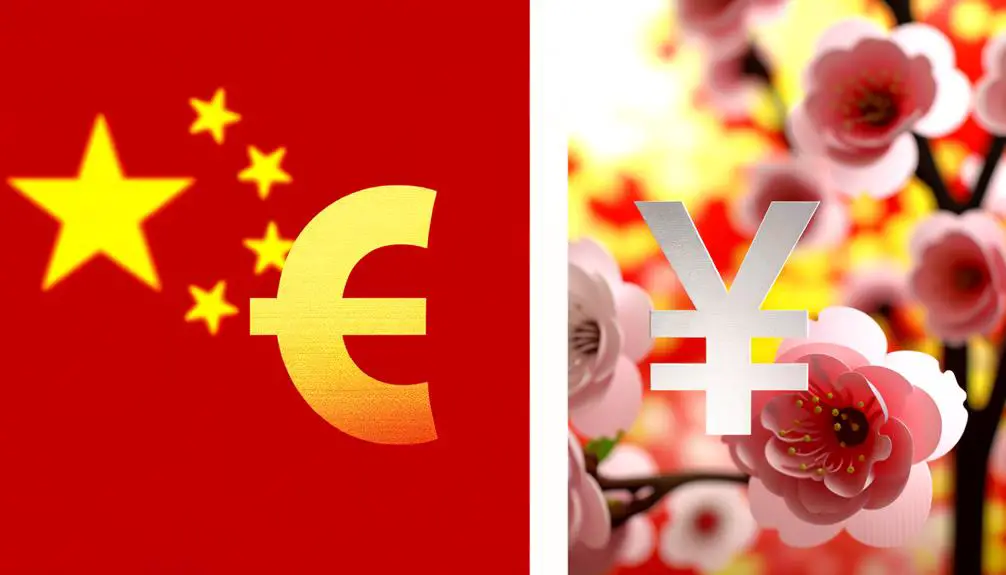
Key Takeaways
- Both Chinese yuan and Japanese yen symbols are represented by the same character (¥).
- The Chinese currency is officially called Renminbi (RMB), with the yuan as its basic unit.
- The Japanese yen has been a freely traded currency since the 1970s.
- The yuan supports China's export-driven economy with a managed float exchange rate.
- The yen is significant in global finance with a stable purchasing power and low inflation rates.
Symbol Similarities
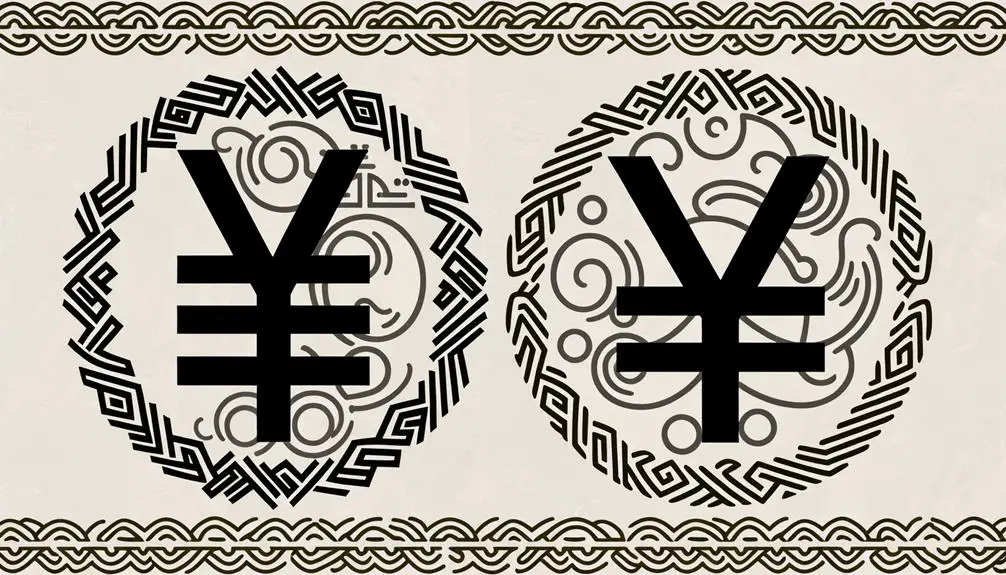
Both the Chinese currency symbol (¥) and the Japanese Yen symbol (¥) share remarkable visual similarities, which often leads to confusion among those unfamiliar with their distinct economic contexts.
While both symbols feature a stylized 'Y' with two horizontal strokes, it is essential to understand their respective uses.
The Chinese Yuan (CNY) and the Japanese Yen (JPY) are two of the world's major currencies, but their symbols are identical in appearance. This similarity can pose challenges in financial documents and online transactions, where context is key to accurate interpretation.
According to data from the International Monetary Fund (IMF), the CNY and JPY rank among the top eight most traded currencies globally, further emphasizing the significance of recognizing their distinct economic roles.
Historical Background
The historical background of the Chinese yuan (CNY) and Japanese yen (JPY) reveals distinct origins and developmental trajectories shaped by their respective economic policies and historical contexts.
The introduction of the yen in 1871 and the yuan in 1889 marked significant milestones that influenced both domestic and international trade.
Analyzing the economic impacts, these currencies have played pivotal roles in regional economic stability and growth, reflecting broader geopolitical and economic trends over time.
Origins and Development
Tracing the historical trajectories of Chinese and Japanese currencies reveals distinct developmental pathways that reflect each nation's unique socio-economic and political contexts.
The Chinese currency, the yuan (¥), originated from ancient metallic coins used during the Qin Dynasty (221-206 BCE). Over centuries, it evolved through various forms, including paper money introduced during the Tang Dynasty (618-907 CE).
Conversely, the Japanese yen (¥) was officially adopted in 1871, influenced by the Meiji Restoration's modernization efforts. Unlike China's prolonged history of currency evolution, Japan's yen was part of a broader strategy to align its economy with Western standards.
These divergent origins underscore differing historical experiences, highlighting China's gradual monetary changes versus Japan's rapid adaptation during the late 19th century.
Economic Impacts
Analyzing the historical economic impacts of the Chinese yuan and Japanese yen reveals significant differences in their roles within domestic and global markets. The yuan, with its tightly controlled exchange rate, primarily supports China's export-driven economy. Conversely, the yen has been a freely traded currency since the 1970s, playing a pivotal role in global finance and trade.
| Metric | Chinese Yuan (CNY) | Japanese Yen (JPY) |
|---|---|---|
| Exchange Rate Policy | Managed Float | Free Float |
| Global Reserve Currency | Limited | Significant |
| Historical GDP Growth | Rapid (Post-1980s) | Moderate (Post-1970s) |
This table highlights key differences that have shaped their economic influence, reflecting China's growth trajectory and Japan's established financial stability.
Currency Names
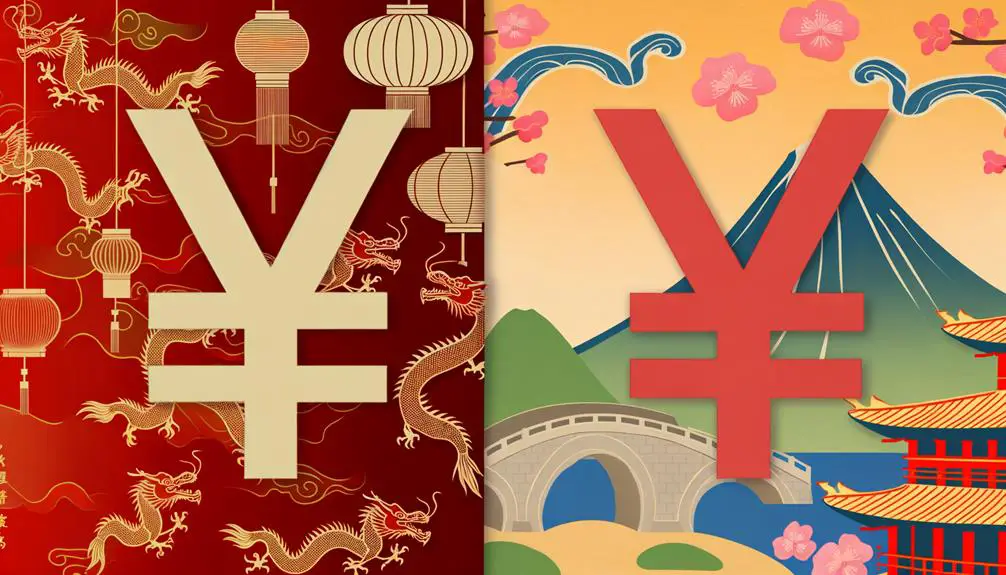
Examining the distinctions between Chinese and Japanese currency names reveals significant historical and linguistic influences on their respective nomenclatures.
The Chinese currency is officially termed the Renminbi (RMB), which translates to 'People's Currency,' while its basic unit is the yuan (元). The yuan symbol (¥) resembles the Japanese yen symbol due to shared historical roots in Chinese characters.
Conversely, the Japanese currency, the yen (円), translates directly to 'round' and signifies the circular shape of coins. Historical records show that both names emerged in the late 19th century, reflecting modernization efforts and interactions with Western economic systems.
Consequently, these names encapsulate unique cultural and historical identities, influencing their contemporary economic narratives.
Official Usage
The official usage of the Chinese yuan (¥) and the Japanese yen (¥) in global financial markets underscores their significant roles in international trade and investment.
The yuan, denoted as CNY, is the official currency of the People's Republic of China and is managed by the People's Bank of China. It is increasingly used in cross-border trade settlements and is a part of the IMF's Special Drawing Rights (SDR) basket.
Conversely, the yen, symbolized as JPY, is Japan's official currency and is managed by the Bank of Japan. As a major reserve currency, the yen is widely used in foreign exchange markets and international financial transactions.
Both currencies are pivotal in shaping global economic dynamics.
Economic Impact
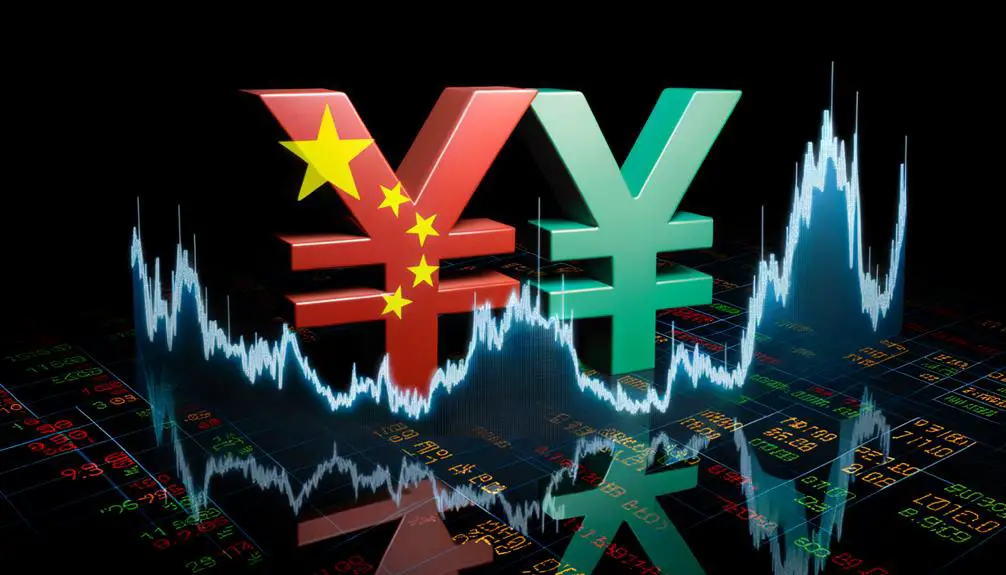
Building on their official usage, the economic impact of the Chinese yuan and Japanese yen extends beyond their home countries, influencing global trade patterns, investment flows, and currency markets.
The yuan's inclusion in the IMF's Special Drawing Rights (SDR) basket highlights its growing importance. As of 2022, China accounted for roughly 17% of global GDP, enhancing the yuan's role in international finance.
Conversely, the yen, traditionally a safe-haven currency, remains pivotal in forex markets, comprising approximately 5.6% of global reserves. Japan's substantial outward investments, valued at over $1 trillion, further solidify the yen's international economic footprint.
Analyzing these data points underscores the significant, yet distinct, roles both currencies play in shaping the global economic landscape.
Global Trade Roles
Both the Chinese yuan and Japanese yen play important roles in facilitating global trade, with the yuan increasingly used in cross-border transactions and the yen serving as a benchmark currency in Asia. The yuan's rise is supported by China's Belt and Road Initiative, which promotes the use of its currency in international projects. Meanwhile, the yen's stability and liquidity make it a preferred reserve currency among central banks.
| Currency | Key Role in Global Trade |
|---|---|
| Yuan | Cross-border transactions |
| Yen | Benchmark in Asian markets |
| Both | Key reserve currencies |
Analyzing trade volumes, China's trade surplus boosts the yuan's international usage, while Japan's advanced financial infrastructure sustains the yen's prominence. Both currencies underpin regional economic stability and influence global trade dynamics significantly.
Exchange Rates
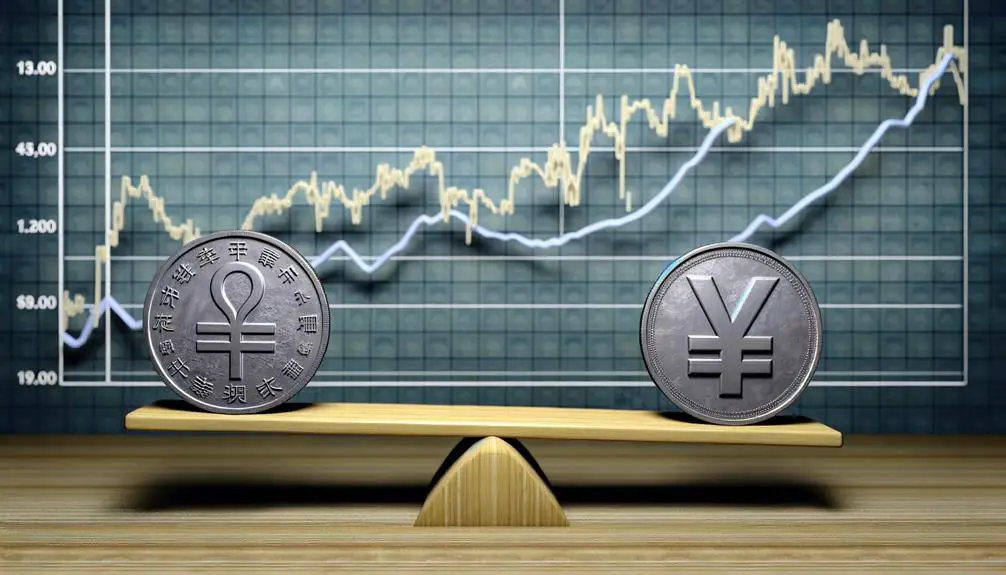
Analyzing the exchange rates between the Chinese yuan (CNY) and the Japanese yen (JPY) reveals significant historical trends influenced by economic policies and market conditions.
Current market influences, such as trade dynamics and monetary policies, play critical roles in shaping their relative values.
Future rate predictions hinge on economic forecasts and geopolitical developments, requiring continuous monitoring for accurate financial planning.
Historical Exchange Rate Trends
Historical exchange rate trends between the Chinese yuan (CNY) and the Japanese yen (JPY) reveal significant fluctuations influenced by various economic policies, geopolitical events, and market dynamics.
Data from the past two decades shows periods of both appreciation and depreciation for both currencies. For instance, the yuan's gradual appreciation from 2005 to 2015 correlates with China's economic growth and controlled currency reforms. Conversely, the yen's volatility during the 2008 financial crisis and subsequent years reflects Japan's economic challenges and aggressive monetary easing policies.
Analysis of historical data also underscores the impact of trade balances, interest rates, and inflation differentials between China and Japan. These patterns provide vital insights into the currencies' relative strengths over time.
Current Market Influences
Current exchange rates between the Chinese yuan (CNY) and the Japanese yen (JPY) are greatly influenced by divergent monetary policies, trade dynamics, and geopolitical tensions.
Key factors include:
- Monetary Policy: The People's Bank of China (PBOC) adopts a more interventionist stance compared to the Bank of Japan's (BOJ) ultra-loose monetary policy.
- Trade Balance: China's trade surplus contrasts with Japan's trade deficits, impacting currency demand.
- Geopolitical Tensions: Regional stability concerns, particularly in East Asia, exert significant pressure on both currencies.
- Economic Performance: China's higher GDP growth rate compared to Japan's slower economic expansion affects investor confidence and exchange rates.
Future Rate Predictions
Forecasting future exchange rates between the Chinese yuan (CNY) and the Japanese yen (JPY) necessitates a thorough analysis of economic indicators, policy trends, and geopolitical developments. Key economic indicators such as GDP growth rates, inflation levels, and trade balances play pivotal roles.
China's economic policies, particularly regarding the Belt and Road Initiative, could influence CNY valuation, while Japan's monetary policy under the Bank of Japan's guidance will affect JPY. Additionally, geopolitical factors, including trade tensions or alliances, can cause volatility.
Analysts often use econometric models and historical data to predict these movements. While precise forecasts are challenging, ongoing monitoring of these variables provides insights into potential future rate trends.
Purchasing Power
To understand the purchasing power of the Chinese yuan compared to the Japanese yen, it is essential to analyze their respective inflation rates, interest rates, and economic conditions. This analysis allows for a thorough evaluation of each currency's strength and its impact on consumers and businesses.
Key factors include:
- Exchange Rates: The relative value of the yuan and yen in global markets.
- Consumer Price Index (CPI): Reflects the cost of a standard basket of goods and services in both countries.
- Gross Domestic Product (GDP) Growth: Indicates economic health and potential currency appreciation.
- Monetary Policies: Central bank policies that influence the money supply and interest rates.
Inflation Rates
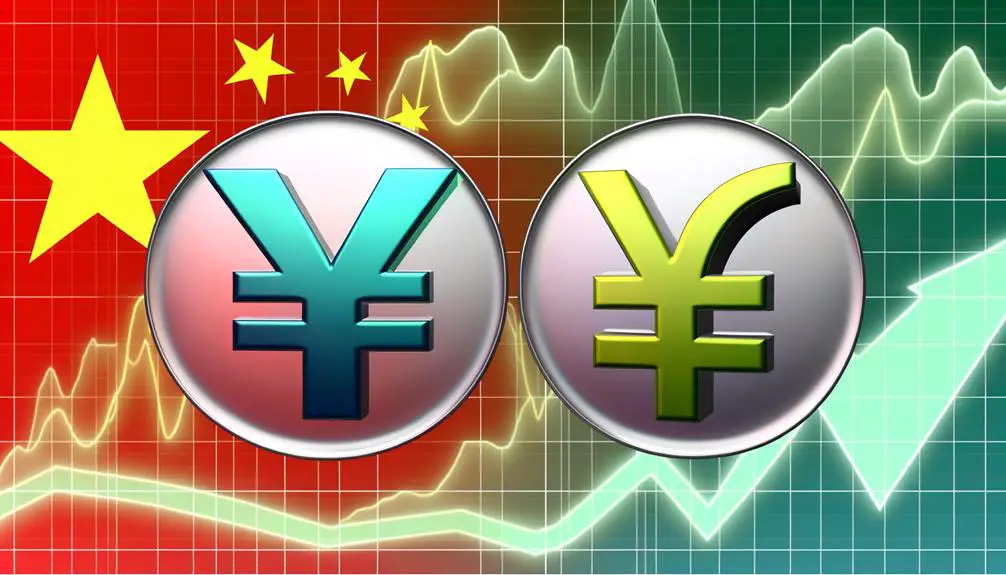
Analyzing the inflation rates of China and Japan reveals critical insights into the purchasing power dynamics between the yuan and the yen.
Historically, Japan has experienced a prolonged period of low inflation, often bordering on deflation, with rates averaging around 0.5% over the past decade.
In contrast, China's inflation rate has been more variable, typically ranging from 1.5% to 3%, influenced by rapid economic growth and fluctuating commodity prices.
This disparity in inflation rates affects the relative value of each currency, with the yen generally maintaining more stable purchasing power.
Consequently, these differences underscore the broader economic conditions influencing each currency and have significant implications for international trade and investment strategies.
Monetary Policies
Monetary policies in China and Japan reveal stark contrasts in their approaches to managing economic stability and growth. China employs a more centralized strategy, with the People's Bank of China (PBOC) actively intervening in financial markets. In contrast, Japan's Bank of Japan (BOJ) has adopted unconventional methods to counter prolonged deflation.
Key differences include:
- Interest Rates: BOJ maintains negative interest rates, while PBOC uses a moderately high rate.
- Quantitative Easing: BOJ extensively uses QE, whereas PBOC prefers targeted stimulus.
- Currency Interventions: PBOC frequently intervenes to stabilize the Renminbi, while BOJ intervenes less often.
- Inflation Targeting: BOJ explicitly targets 2% inflation, while PBOC does not have a fixed target.
These strategies reflect each country's unique economic challenges and policy goals.
Future Projections
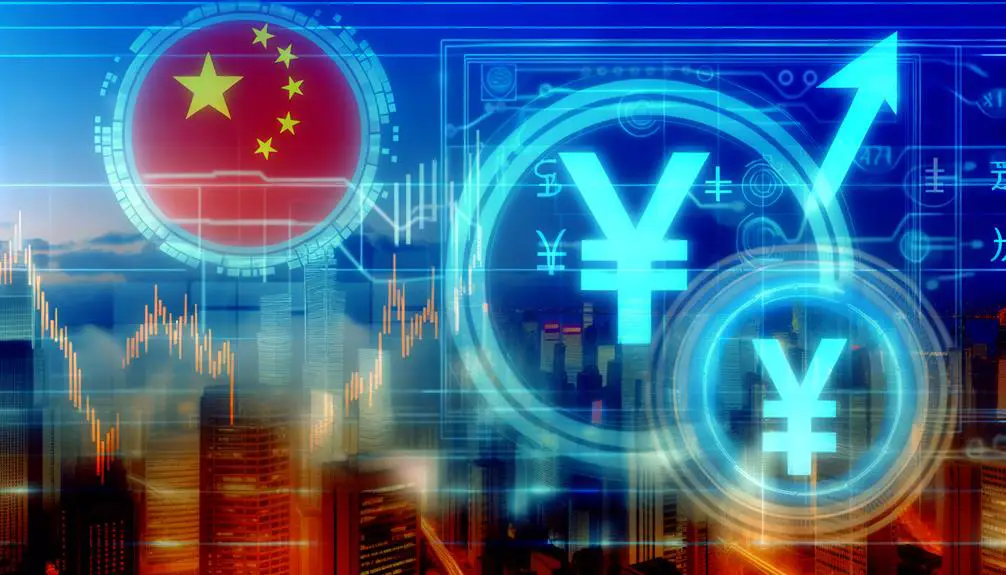
Future projections for the Chinese currency and the Japanese yen require a close examination of economic growth predictions and currency valuation trends. Data from international financial organizations suggest that China's GDP growth rate may outpace Japan's in the coming years, potentially affecting the relative strength of their currencies.
Additionally, historical trends in currency valuation indicate differing trajectories influenced by each country's monetary policy and economic stability.
Economic Growth Predictions
Projecting the economic growth trajectories of China and Japan requires a thorough analysis of their respective fiscal policies, demographic trends, and global market positions. China's economic outlook is influenced by its robust manufacturing sector and ambitious infrastructure projects. Conversely, Japan's mature economy faces challenges related to its aging population and reliance on technological innovation for growth.
Key factors influencing future projections include:
- Fiscal Policies:
- China's expansionary fiscal policies
- Japan's conservative approach
- Demographics:
- China's growing workforce
- Japan's shrinking, aging population
- Global Market Position:
- China's increasing global trade influence
- Japan's established but static market
- Technological Investment:
- Japan's advanced technology sector
- China's rapid tech adoption and innovation
Understanding these elements is essential for making accurate economic growth predictions.
Currency Valuation Trends
Analyzing current trends, the valuation of the Chinese yuan and Japanese yen will be greatly impacted by differential interest rates, trade balances, and foreign exchange reserves over the next decade.
For instance, China's robust economic policies and significant foreign exchange reserves suggest a potential appreciation of the yuan. Conversely, Japan's continued low interest rates and high public debt may exert downward pressure on the yen.
Trade balances are another important factor; China's trade surplus could support the yuan, while Japan's trade deficits might weaken the yen.
Market confidence and geopolitical developments will also play pivotal roles. Projections indicate a complex interplay of these factors, necessitating close monitoring for accurate forecasting in currency valuation trends.
Conclusion
To wrap up, while the Chinese currency symbol and the Japanese yen share superficial similarities, their historical contexts, economic impacts, and monetary policies diverge substantially.
The economic influence of each currency on global markets cannot be downplayed, reflecting distinct trajectories in purchasing power and inflation rates.
Therefore, understanding these currencies requires a nuanced analysis that goes beyond mere symbols, delving into the complex interplay of historical, economic, and policy-driven factors that shape their futures.




